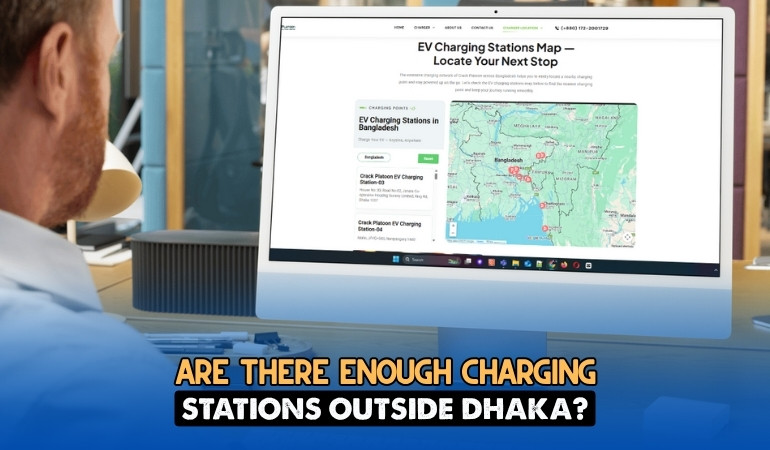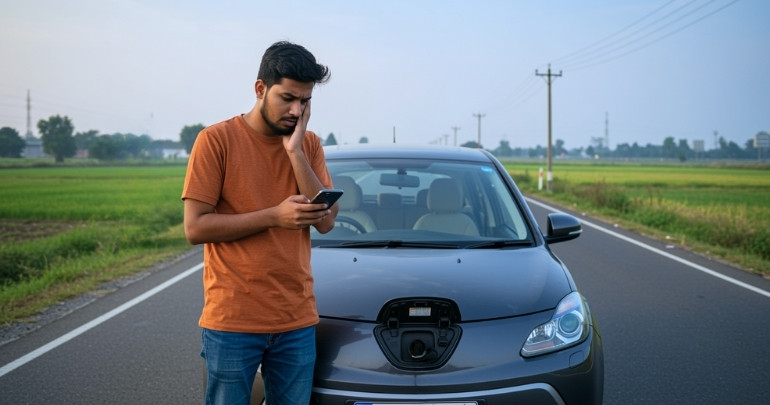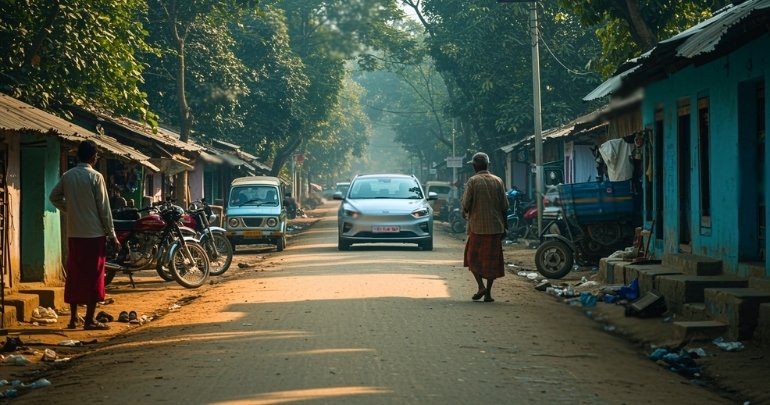Electric vehicles (EVs) are becoming more popular in Bangladesh. They are cheaper to run and better for the environment than regular cars. In Dhaka, more people are using EVs, and some charging stations have been set up. But what about the rest of the country? Are there enough charging stations outside Dhaka?
Sadly, no. Only a few cities like Comilla, Narayanganj, and Chittagong have some stations. The first one outside Dhaka was opened not long ago in Jessore. That’s not nearly enough. Bangladesh needs many more stations to support EV drivers across the country.
Want to know what this means for EV users and the future of transport? Keep reading to find out more.
Are There Enough Charging Stations Outside Dhaka?
Electric vehicles are slowly becoming more common in Bangladesh. But outside Dhaka, charging options are still very hard to find. Less than 100 public stations are available across the whole country. Only 14 of them are officially approved, and most are in big cities.
Even though more people in Bangladesh are using electric vehicles (EVs), there are still very few charging stations outside Dhaka. This is happening because of many problems that are all connected. Let’s look at them in simple terms.

Not Enough Chargers and Fear of Running Out
Most charging stations are only in Dhaka or a few big cities. In smaller towns, there are hardly any. Because of this, people worry about their EVs running out of power on the road. This fear stops many from using EVs outside Dhaka.
Few EVs Mean Less Business for Stations
In many areas, only a small number of people drive EVs. This means charging stations don’t get enough users to make money. Owners don’t want to open new stations if no one will use them. Without help from the government, most avoid investing.
EVs Are Expensive and Rules Are Not Clear
Buying an EV costs a lot, and there are high taxes on them. There’s also no strong rule or plan to support EV use in smaller towns. Without local factories or better import systems, prices stay high. This slows down the setup of new stations.
People Don’t Know Enough About EVs
There are many places where people do not fully understand how electric vehicles work. Mechanics and sellers also don’t have the right skills. This lack of knowledge makes it harder to build support systems for EVs. So, growth is much slower in those regions.
Electricity Problems and Weak Power Grids
Our power system is already under stress. EV charging needs a lot of electricity, and many areas can’t handle the extra load. Fixing this will take time and money. Until then, charging stations will be hard to set up.
Stations Are Ready But Still Not Working
Some stations are built but are not yet open. The reason is they’re waiting for price rules and government permissions. This causes delays in giving EV users the help they need. That’s why EV charging stations in Bangladesh are still not enough outside the capital.
How Does the Lack of Charging Stations Affect Long-distance Travel in Bangladesh?
Electric cars are getting more popular in Bangladesh, and many people want to travel farther with them. But making long trips in an EV can be tough because of a big problem. There aren’t enough places to charge on the road outside major cities. Here’s how this affects people trying to take long drives in Bangladesh.

Range Anxiety and Travel Difficulty
Many EV drivers feel scared about running out of power far from home. They don’t always know where the next charging station is. This worry keeps people from taking longer trips. Nobody wants to get stuck on the road with a dead battery. That’s why most only drive short distances.
Highway Charging Infrastructure Lacking
Highways don’t have many charging stations yet. It’s hard for drivers to find a spot to charge during long trips. Fast-charging stations on highways would help, but there aren’t enough of them. Because of this, long highway drives in an EV are risky. Most people just don’t want to take the chance.
Limited Availability and Long Waiting Times
With so few stations, drivers often have to wait in line. Sometimes, the wait is very long because many people need to charge at the same place. This can mess up travel plans and make trips take much longer. Waiting around isn’t fun for anyone. It’s a big reason people skip EVs for long journeys.
Unstable Electricity Supply
Some areas don’t have a steady electricity supply. Charging stations there might not always work if the power goes out. Drivers can’t count on these stations being open. This makes certain roads and towns hard to visit with an EV. It limits where people feel safe driving.
Economic and Planning Challenges
Building new charging stations, especially on highways, costs a lot of money. Many businesses worry they won’t make enough profit. Without help from the government, the growth of stations stays slow. There also isn’t enough planning to put stations where drivers really need them. All this holds back long-distance EV travel.
What Plans Exist to Increase Private Investment in EV charging Infrastructure?
Electric vehicles are growing in popularity, but charging spots are still hard to find across Bangladesh. To fix this, several private companies and government policies are working together. Their goal is to build more charging stations in smart places where people can easily use them.
Company-Led Projects
- Progress Motors is building fast chargers on busy roads like Dhaka-Chittagong without asking for outside money or support. Their plan includes adding more stations near malls, resorts, and popular spots in the north and east.
- Genex Infrastructure and CG Runner want at least 10 new stations near Dhaka and on major highways soon. They plan to support BYD electric car users first, then expand to serve everyone on the road.
- Rancon Motors will set up 21 stations by April 2024 in busy areas like tourist spots and hotels. They are offering free charging for their customers at first to help more people try EVs easily.
Government Policies and Help
- The government made two new policies to help people build and run charging stations across the country. These rules make it easier for private groups to open stations without facing too many problems.
- There are tax cuts for people who invest in making or selling electric car parts or charging tools. These tax breaks help bring in more money and interest from new companies.
- Another plan, called the Automobile Policy 2020, gives extra help to set up factories and testing labs. This support helps create better tools and builds trust in EV technology.
Focused Investment Areas
- Many new stations will be placed on highways where drivers need quick charging during longer trips. This can help ease people’s fear of being stuck far from a charger.
- Cities and business zones are also top choices to place new charging spots near offices, shops, and homes. These areas have lots of drivers who need easy access to chargers every day.
- Some companies are also adding stations near parks, resorts, and hotels to help tourists charge while relaxing. In these places, the time needed to charge EVs feels shorter because people are already spending time there.
Smart Charging Network Goals
- Businesses are not just adding chargers; they are thinking of smart networks that connect well across cities and roads. This helps drivers find chargers faster and feel more confident about switching to EVs.
- These networks will help build strong support for EVs by linking all major travel points and daily destinations. A good network can make the EV switch smooth for people living outside Dhaka.
- All these plans aim to help Bangladesh reach its 2030 goal of getting 30% of vehicles running on electric power. Without a solid network, the shift would be slow and hard to manage.
Are Government Subsidies Enough to Make Charging Stations Profitable Long-term?
Charging stations for electric cars are important for Bangladesh’s future, but making money from them is not always easy. At first, there are not enough EVs on the road, so stations don’t get many customers. This means the government needs to help with subsidies and support so businesses can survive in the beginning. Here are the factors that matter for long-term profits.
Location Matters for Profit
Bus stops, city centers, and markets can all be good places to place charging stations. These locations get a lot of visitors who need to charge their vehicles often throughout the day. Profits can be much higher in these spots compared to quiet or rural areas. Station owners want to set up in places where people use electric vehicles the most.
Help From the Government
Government support is important for new charging businesses to cover their start-up and running costs early on. Policies, tax breaks, and incentives lower the amount of money needed to open new stations everywhere. These measures make it easier for private owners to take a chance on new locations. With this help, more stations can open while EV use is still growing.
Importance of a Stable Power Supply
Charging stations need steady electricity to work well and keep costs low for owners and customers. Areas with good power grids help stations save money on running their business every month. Stable electricity means fewer breakdowns and happier customers who trust the service. When stations can rely on the power supply, profits are easier to keep up.
Growing Demand Over Time
As more people buy electric cars, charging stations will have more regular customers every day and month. Higher demand means station owners won’t need as much government help in the future. Businesses become more attractive for private investment when they are used more often. Over time, steady customer growth can make stations a good, long-lasting business.
How Do Current Charging Station Locations Impact Rural EV Adoption?
Electric vehicles are slowly becoming more common in Bangladesh, but rural areas still face many problems. One big issue is the lack of charging stations outside cities and on highways. This keeps many rural people from using or buying EVs at all.

City and Highway Focus
Charging stations are mostly built in busy cities like Dhaka and along routes such as the Dhaka-Chittagong highway. These places get the most attention because they have more people and cars. Rural roads are left out, even though people there also need clean transport. This setup helps urban drivers but blocks rural EV growth completely.
No Easy Charging Access
Many rural towns do not have any nearby charging stations to support electric vehicle use. People living there worry they’ll run out of battery. That fear makes owning an EV feel unsafe or too risky for everyday use. Without access, people just stick to fuel-based vehicles they already trust.
Power Supply Is Unstable
Electricity in rural areas often cuts off or has low power levels, causing many service issues for chargers. Even if a station is built, it may not work properly or stay active. This makes both charging and travel plans very hard for drivers. Poor electricity pushes people away from trying something new like EVs.
Travel Options Become Limited
Rural families use vehicles for school trips, hospital visits, or work in far-away fields and towns. But without chargers nearby, those trips are harder with electric cars. The long-trip readiness of EVs remains poor in villages, stopping people from making important travel decisions. This issue keeps electric cars stuck in short-range use.
Early Efforts Are Too Few
Groups like the Bangladesh Rural Electrification Board have built some rural chargers, but these are very limited in number. One station won’t support everyone across a big area with many drivers. Real change needs more chargers placed where people actually live and travel. So far, those plans are still small and slow.
FAQs About EV Charging Coverage Outside Dhaka
Electric vehicles are on the rise in Bangladesh, but charging station availability outside Dhaka is still a concern. Many EV users and interested buyers have common questions about rural and regional access. Here are 10 FAQs to help clarify the situation.
What Areas Outside Dhaka Have the Most Charging Stations?
Most stations outside Dhaka are in cities like Chittagong, Comilla, Narayanganj, and recently, Jessore. These are urban or highway locations. Rural towns have very few or none. Expansion is slow, but is expected to grow over time.
Why Aren’t Investors Building Stations in Small Towns?
Investors worry that fewer EV users in small towns mean low profits. Without strong demand, many avoid building there. Government incentives help, but they’re not always enough. Investors focus more on cities where profits are safer.
Do Any Charging Stations Exist in Tourist Areas?
Some companies are starting to place chargers near resorts, hotels, and tourist zones. These areas attract higher traffic. Rancon Motors is one example targeting such locations. It helps travelers but doesn’t fully solve rural charging issues.
How Do EV Users in Villages Manage Charging?
Most rural EV users charge at home using standard power connections. Long trips are rare due to limited public chargers. They avoid distant travel to reduce risks. This limits the full use of their electric vehicles.
Are Portable Charging Solutions Available Outside Dhaka?
Portable EV chargers exist but are rare in Bangladesh. They’re more common in private fleets or emergency setups. Public use isn’t yet widespread. Most rural areas still depend on fixed stations or home charging setups.
Do Charging Stations Work During Load Shedding?
Some charging stations face outages during load shedding in rural areas. Stations without backup power systems shut down. This affects reliability and user trust. Urban stations are more likely to have stable service and backup support.
Are EV Charging Stations Safe in Remote Locations?
Safety depends on maintenance, lighting, and security features at the site. Many rural areas lack proper infrastructure. This can make users feel unsafe charging at night. More planning is needed to improve safety in those regions.
How Far Apart Are Charging Stations Outside Dhaka?
Outside Dhaka, charging stations are often far apart, sometimes over 100 km. This distance causes range anxiety. Drivers need to plan carefully for longer routes. More stations are needed to cover gaps between towns and cities.
Are EV Charging Stations Open 24/7 Outside Cities?
Most rural stations, if they exist, don’t stay open all day. Many follow business hours or depend on local staff. This limits charging access during emergencies. Cities usually offer more flexible service times.
What’s Being Done to Add More Stations in Rural Areas?
Some government and private groups are planning rural expansion. The Bangladesh Rural Electrification Board has started with one pilot station. More efforts are promised. But widespread access will take time, planning, and steady investment.
Final Considerations
Electric cars are becoming more common in Bangladesh, but many places still don’t have enough charging stations. This makes it hard for people outside big cities to use EVs every day. So, are there enough charging stations outside Dhaka to support all users?
Right now, there aren’t. Many towns don’t have stations, and some that exist don’t work well. Without better plans and more support, this won’t change soon. But if the government and companies work together, more people can use EVs across the country. It’s a slow start, but there is still hope for a better future.
